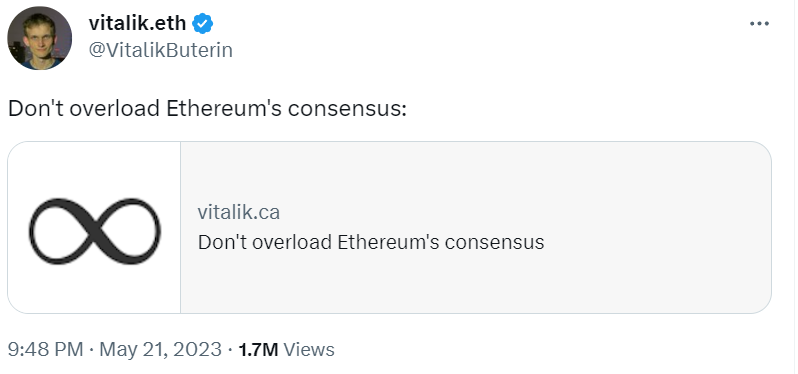Ethereum Might Get Overloaded

This blog post will cover:
- What happened
- Possible solutions
On May 21st, 2023, the father of the second global decentralized network shared a post alerting the overload of the Ethereum (ETH) consensus due to a subgroup of used mechanics. He provided a few solutions and explained how they could help prevent the systemic risks. Vitalik has posted a link in his Twitter profile as well:
Let’s dive a little deeper into the topic and see what Ethereum founder worries about and what has to be done to change the situation.
What happened
A tweet recently emerged in Ethereum CEO’s profile, asking not to overload the consensus of Ethereum. Fast fact: consensus is a procedure when blocks are approved by the technology of PoS, which was executed in 2022 along with the Merge.
The key problem described in Vitalik’s post is the appearance of a big amount of suggestions proposing to utilize Ethereum consensus for different intentions. This, as Vitalik fears, might enlarge the blockchain and lead to overload:
Which exact technologies are mentioned by Vitalik? Here’s a short reference you might find useful.
- Data oracles Oracle algorithms are utilized within the blockchain technology to transfer data between a smart contract and an external source. This technology finds widespread use in DApps, including NFTs, GameFi, insurance, and DeFi. Smart contract operations in DApps require access to a range of external data. For instance, calculating the exact cryptocurrency exchange rate requires information from external sources. This data enables the computation of a "fair" price as closely aligned to the market as possible. Many blockchain oracles run on a node in a particular blockchain, such as Ethereum's node.
- Re-stakingRe-staking is staking tokens that were already staked. A special protocol allowing Ethereum stakers to do this was not long ago put on testnet. It is called EigenLayer.
- Recovery of L2 The second layer is a protocol deployed over the main blockchain (L1) to build up its scalability. It was brought up that if a L2 has a bug, the L1 might fork to restore it.
The Ethereum CEO notified that the subgroup of these technologies can come with severe systemic risks for the whole ecosystem. He specifically highlighted bugs and intended attacks.
Among the risky cases given there was the generation of ETH/USD cost oracles where the validators or holders of ETH can become corrupt to vote on. This, in turn, may cause a “fork out the bad participants' money” in the event of disagreement.

Possible solutions
Vitalik Buterin shared various options to address potential risks. He mentioned a necessity to implement better oracles and take a case-by-case approach as various problems are fundamentally distinct.
He cautioned against application-layer projects that risk expanding the blockchain consensus beyond verifying the core Ethereum protocol rules. Vitalik suggested supporting re-staking uses that do not extend the Ethereum consensus while assisting devs to discover other strategies to achieve their security goals. Buterin also recommended lowering reliance on cross-chain bridges, which have faced multiple attacks in recent years.
Overall, considering the risky technologies mentioned above, Vitalik Buterin offered a number of solutions such as minimally relying on bridges, utilizing the Eth validator set to protect other chains, using more complex oracles etc.
Now it’s quite early to draw any conclusions as to whether this is a working scheme. These solutions might show some results after the team of Ethereum starts implementing the ideas to save the network from the overload.
In 2022, Ethereum's consensus mechanism moved from PoW to PoS. Additionally, staked Ethereum has only just been released for withdrawal with the Shapella upgrade on April 12. That’s the reason why there’s now greater attention on validator responsibilities and security threats within the world's biggest smart contract network.
What Ethereum’s up to? SimpleSwap will keep an eye on the situation and give you updates as quickly as possible. Stay tuned!



